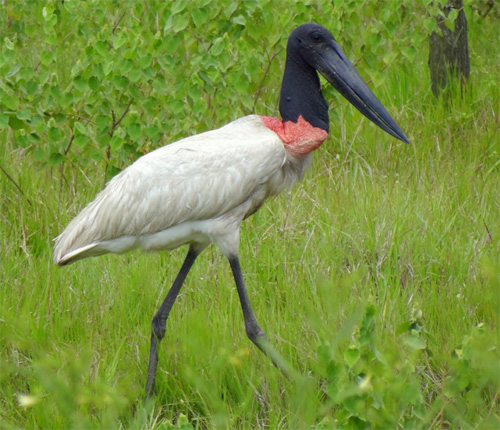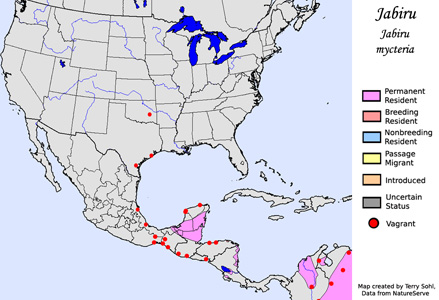| Length: 48 - 56 inches | Wingspan: 7.5 - 9 feet | Seasonality: Non-resident in South Dakota |
| ID Keys: Very large size, very large broad bill, black head, reddish neck, white body | ||
 Jabiru,
a species of stork, are among the largest birds in the Americas, with large
males standing as tall as 5 feet and weighing over 20 pounds. They are
birds of the tropical Americas, and are most common in South America, with
smaller populations in central America and southern Mexico. Stray
Jabiru have been found in the U.S. on a handful of occasions in south Texas,
but one bird was found as far north as Oklahoma. Jabiru is name that
has also been applied to a pair of other species that live in the Eastern
Hemisphere, but they are more properly titled the "Asian Black-necked Stork"
(called Jabiru in Australia), and the "Saddle-billed Stork" of Africa.
Jabiru,
a species of stork, are among the largest birds in the Americas, with large
males standing as tall as 5 feet and weighing over 20 pounds. They are
birds of the tropical Americas, and are most common in South America, with
smaller populations in central America and southern Mexico. Stray
Jabiru have been found in the U.S. on a handful of occasions in south Texas,
but one bird was found as far north as Oklahoma. Jabiru is name that
has also been applied to a pair of other species that live in the Eastern
Hemisphere, but they are more properly titled the "Asian Black-necked Stork"
(called Jabiru in Australia), and the "Saddle-billed Stork" of Africa.
Habitat: Can be found in a variety of tropical habitats, near rivers and lakes.
Diet: Jabiru eat a variety of animals, including large numbers of fish, crustaceans, mollusks, and amphibians. They will also eat reptiles, small mammals, small birds, eggs, and carrion. Opportunistic feeders, with groups of birds often showing up in areas with feeding opportunities, such as drying pools with fish during dry spells.
Behavior: While never appearing in huge numbers, Jabiru can be relatively social, with several birds or small flocks feeding in the same location. Feeding behavior depends upon locality and the type of prey that are available.
Nesting: Jabiru build very large nests, up to 4 feet wide and 6 feet deep. The nests are constructed of sticks and branches, and are made by the male and female. They typically do not nest in large colonies, but several nests may be in close proximity. They are thought to mate for life, and are very protective parents, with adults taking care of young for 6 months or more after hatching.
Song: Jabiru are typically silent, although occasionally a low whistle may be heard.
Migration: Permanent resident throughout its range.
Interactive eBird map: Click here to access an interactive eBird map of Jabiru sightings
Similar Species: Generally unmistakeable. Structure similar to other stork species that has reached the U.S., the Wood Stork.
Conservation Status: The species was once listed as "threatened" by the IUCN, but as of 1988, is now considered a species of "least concern". They are not common in most areas, but they are widespread, and received protected status in several South American countries.
Further Information: 1) Cornell's Neotropical Birds - Jabiru
2) AvianWeb - Jabiru
Photo Information: October 11th, 2011 - Venezula - Taken by Flickr member Barlovetomagico - Licensed under Creative Commons Attribution-NonCommercial-NoDerivs 2.0 Generic license.
Additional Photos: Additional Photos Coming Soon!!
| Click below for a higher-resolution map |
 |
| South Dakota Status: Non-resident in South Dakota |
Additional Jabiru Photos (coming soon!!)
